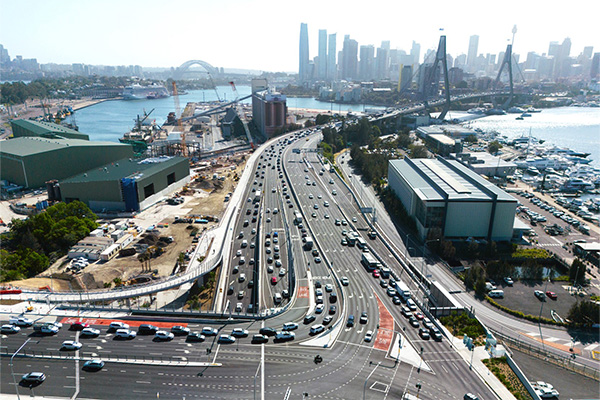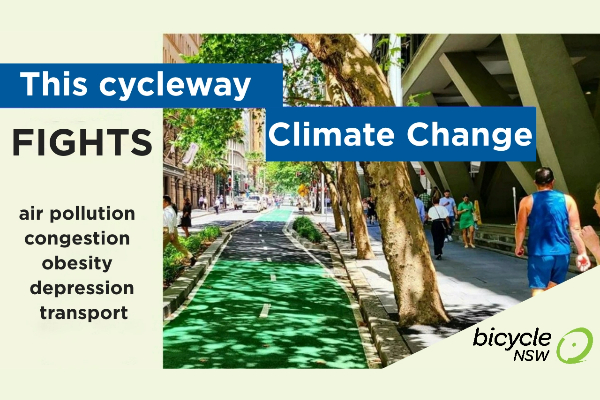There's a golden opportunity along three of Australia’s oldest roads
Parramatta Road is Australia’s ugliest, noisiest, dirtiest road. Half of the businesses along it are empty soot-caked shells. Its life has been sucked dry by 70 years of planning for cars. However, it’s also Australia’s first road with an amazing heritage, still visible under all the filth.
Our article Breathing Life into Parramatta Road explores the descent of Parramatta Road, Victoria Road and Oxford Street into traffic sewers that fail to move people efficiently or attract them to linger. They are 'stroads', lifeless places that fail at both movement and place functions. Parramatta Road at Lewisham
(Image: Bicycle NSW)
Similarly, Victoria Road is the place not to be. Unless you’re driving through. As a result, For Let and Closing Down signs festoon shop windows. Those that aren’t smashed and abandoned already. Children scurry across a handful of crossings to get to school. But most get driven by nervous parents, adding to the endless traffic congestion.
The Great Western Highway wreathing from Sydney to Penrith is another begrimed failure in urban planning. Why on earth then would anyone want to live anywhere near these traffic sewers. Let alone invest in them?
The Three Roads Project: A response to Sydney’s perfect housing storm
A response to Sydney’s housing crisis has been developed by Business Sydney, Business Western Sydney and the Housing Industry Association (HIA). The blueprint, outlined here, has a vision for the redevelopment of significant Sydney corridors - Parramatta Road, Victoria Road, and the Great Western Highway - to introduce approximately 75,000 medium-density housing units.
The Three Roads on a map – obvious corridors for new housing. If the oppressive dominance of motor vehicle traffic can be tamed. (Image: Business Sydney)
“Sydney has three golden opportunities to dramatically increase housing supply in the form of Parramatta Road, Victoria Road and the Great Western Highway,” says Paul Nicolaou, Executive Director of Business Sydney. “Each of these roads is crying out for sensible development and is well suited to medium-density housing of up to eight storeys complemented by innovative public transport solutions.
“All three present opportunities to provide a mix of affordable housing to enable essential workers to live closer to where they work.”
Politicians, housing campaigners, sustainable transport advocates and the development lobby are all on one page
The Three Roads plan aligns with Premier Minn’s recent announcements on initiatives to hugely ramp up housing delivery. These include major rezonings, amended planning rules near transport hubs and a return to pattern-book housing designs.
Of course, there are big benefits for developers and landowners from rezonings. But there is plenty for active and public transport advocates to get excited about too! Because it will be impossible to attract investment to these roads without a major transformation of the transport mix. People must be put before cars to unlock the maximum development potential.
A movement and place revolution is essential.
City of Sydney has developed a vision for Broadway as a welcoming space, with a light rail connection and large trees shading wide footpaths and a separated cycleway. Why not extend the vision towards Parramatta?
This is the kind of main road where people will want to live!
(Image: City of Sydney draft Access Strategy and Action Plan)
Reallocating road space is cheap and easier than you think
Bicycle NSW has campaigned hard for road space reallocation on Sydney’s arterial traffic sewers – particularly those now bypassed by new motorways. We argue that existing vehicle lanes can now be used for wider footpaths, separated cycleways, new trees and public transport. The roads will be safer and more efficient. They will be less noisy with better air quality. People will have more choices on how to move around.
As a result, street life will return and businesses will thrive. Which brings us back to the housing question:
Rethinking housing and transport now. Not in 20-30 years.
According to esteemed economist Alan Koheler’s recent essay The Great Divide: Australia's Housing Mess and How to Fix It, “Australian housing wealth is meaningless, destructive and fundamentally changing our society”.
And the road to changing this wicked situation will be a long, hard political struggle. Which, Koheler admits, may not even succeed. Society cannot afford to wait the estimated 20-30 years for proposed changes to improve housing affordability.
But the Three Roads are ripe for an injection of up to 75,000 units. If NSW Labor can grab a once-in-a-generation opportunity to reallocate road space to transform place and attract new life and investment. This requires, in the case of Parramatta Road and Victoria Road, having 2 lanes for cars (rather than 6) and 2 dedicated to public transport – either light rail, rapid buses or trackless trams. And allocating what’s left for pedestrians, parking, bikes and more trees.
Back in May when we wrote Breathing Life into Parramatta Road the general response was, ‘nice idea, but never gonna happen - it’s a lost cause’.
But the cost of living and housing crises have deepened since then. And with the disastrous opening of Westconnex, Victoria Road in Rozelle is now Roze-Hell.
The Rozelle Interchange is mostly underground but the impact on the Inner West at surface level is profound. The failure of recent transport planning has been exposed. No modern, forward-thinking city should have roads like this on the edge of the CBD. Especially not roads built in the 2020s! (Image: Jake Coppinger)
Urgent: kick start the transformation of Victoria Road
The underground toll-free bypass of Victoria Road, between Iron Cove and Anzac bridges, promised to significantly reduce traffic volumes on the Victoria Road corridor. The future vision for Victoria Road has been established in an excellent public domain masterplan for Rozelle.
The Inner West Council concept for Victoria Road. One vehicle lane in each direction with turning lanes at the junctions, continuous bus lanes, a bi-directional separated cycleway, wider footpaths and a lot of new trees. (Image: SMH/Inner West Council)
Recognising that long-term changes had never been ‘in scope’ as part of the massive WestConnex spend, an interim strategy was proposed. By installing low-cost concrete barriers and planters to reclaim road space, traffic expansion could be controlled while permanent fixes are planned and financed. Failing to act now risks losing the chance as cars will reclaim all available space. As we have seen happen in the early weeks of the new interchange.
Light rail is fantastic but must displace vehicle lanes
Bicycle NSW very pleased that the Three Roads plan for Parramatta Road includes light rail (or trackless tram). Because, just one 40 metre light rail holds 450 passengers which in turn removes a 1.6km long line of traffic from the road. Beautiful!
But there is something we urge all stakeholders to consider at a very early stage. For Parramatta Road to thrive, light rail must be fully integrated with a low-traffic, low-speed street scape. George Street has been transformed by light rail, but Anzac Parade is much less successful. This is because Transport for NSW insisted on retaining high levels of service for car traffic. Street parking was removed for clearways. Fast cars and buses run right next to narrow footpaths. There is very little tree canopy. It’s hot and noisy. The amenity for pedestrians and bike riders has not improved much. The development potential of the corridor through Kensington and Kingsford has been compromised by car traffic.
A lot of concrete defines the new Anzac Parade. The light rail is fantastic. But the 24hr clearways, installed to maintain two lanes of general traffic in each direction, mean no trees, parking, kerb extensions, outdoor dining or bike infrastructure. (Image: Google Maps)
Right from the get go, in order to achieve something wonderful for Parramatta Road, vehicle capacity must be sacrificed. The light rail should be combined with a single lane of general traffic, a 40km/h speed limit, a cycleway and parking bays separated by trees and landscaped kerb extensions.
The sub-optimal vision for Parramatta Road shown in the Three Roads paper. The heritage buildings are retained and mixed with mid-rise apartments. But two lanes of general traffic mean no footpath widening, no kerb extensions to make crossing the road easier, no parking to support businesses and protect pedestrians from fast traffic and no cycle infrastructure. A better vision is essential! (Image: Telegraph/Altrec Light Rail)
A renewed Parramatta Road is pivotal to the proposal to alleviate the housing crisis
The Three Roads plan recognizes Parramatta Road's unique potential. Its redevelopment could yield up to 30,000 units, addressing the needs of essential workers and Sydney’s rapidly growing population.
The plan is still at a conceptual stage, but it is very exciting nonetheless. Bicycle NSW looks forward to seeing how it evolves.
As Paul Nicolaou, Executive Director for Business Sydney, points out:
“You can get things started now with pop-up infrastructure. In fact, the earlier the better. The state government and Inner West Council don’t have to spend much at this stage. Nor are we asking them to. Because setting aside a couple of traffic lanes for people sends the signal that Parramatta Road is a place again. When that happens, developers will line up… Just look at where it is. It’s Australia’s first road!”
Something else to get behind!
We’d love you to join Bicycle NSW and support our advocacy for better infrastructure and safer streets. You will also ride easy, covered by our comprehensive insurance and enjoy many other Member-only benefits.









